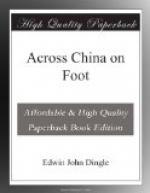[Footnote AF: The marriage laws were instituted by the China Inland Mission at Sa-pu-shan, where a great work is being done among the Hua Miao. A good many more stipulations are embodied in the excellent rules, but I have no room here to detail.—E.J.D.]
[Footnote AG: The Chinese have the crudest ideas of the age of foreigners. Among themselves the general custom is for a man to shave his upper lip so long as his father is alive, so that in the ordinary course a man wearing a moustache is looked upon as an old man. In Tong-ch’uan-fu the rumor got abroad that three “uei kueh ren” ("foreign men”) went riding horses—(two young ones and one old one. The “old one” was myself, because I had hair on my top lip, despite the fact that I was considerably the junior. And the fact that one was a lady was not deemed worthy of the slightest consideration.—E.J.D.]
CHAPTER XVI.
Lu-feng-hsien and its bridge. Magnificence of mountains towards the capital. Opportunity for Dublin Fusiliers. Characteristic climbing. Crockery crash and its sequel. Mountain forest. Changeableness of climate. Wayside scene and some reflections. Is your master drunk? Babies of the poor. Loess roads. Travelers, and how they should travel. Wrangling about payment at the tea-shop. The lying art among the Chinese. Difference of the West and East. Strange Chinese characteristic. Eastern and Western civilization, and how it is working. Remarks on the written character and Romanisation. Will China lose her national characteristics? “Ih dien mien, ih dien mien." A nasty experience of the impotently dumb. Rescued in the nick of time.
When the day shall come for its history to be told, the historian will have little to say of Lu-feng-hsien, that is—if he is a decent sort of fellow.
He may refer to its wonderful bridge, to its beggars and its ruins. The stone bridge, one of the best of its kind in the whole empire, and I should think better than any other in Yuen-nan, stands to-day conspicuously emblematic of ill-departed prosperity. So far as I remember, it was the only public ornament in a condition of passable repair in any way creditable to the ratepayers of the hsien. The wall is decayed, the people are decayed, and in every nook and cranny are painful evidences of preventable decay, marked by a conservatism among the inhabitants and unpardonable indolence.
The bridge, however, has stood the test of time, and bids fair to last through eternity. Other travelers have passed over it since the days of Marco Polo, but I should like to say a word about it. Twelve yards or so wide, and no less than 150 yards long, it is built entirely of grey stone; with its massive piers, its excellent masonry, its good (although crude) carving, its old-time sculpturing of dreadful-looking




